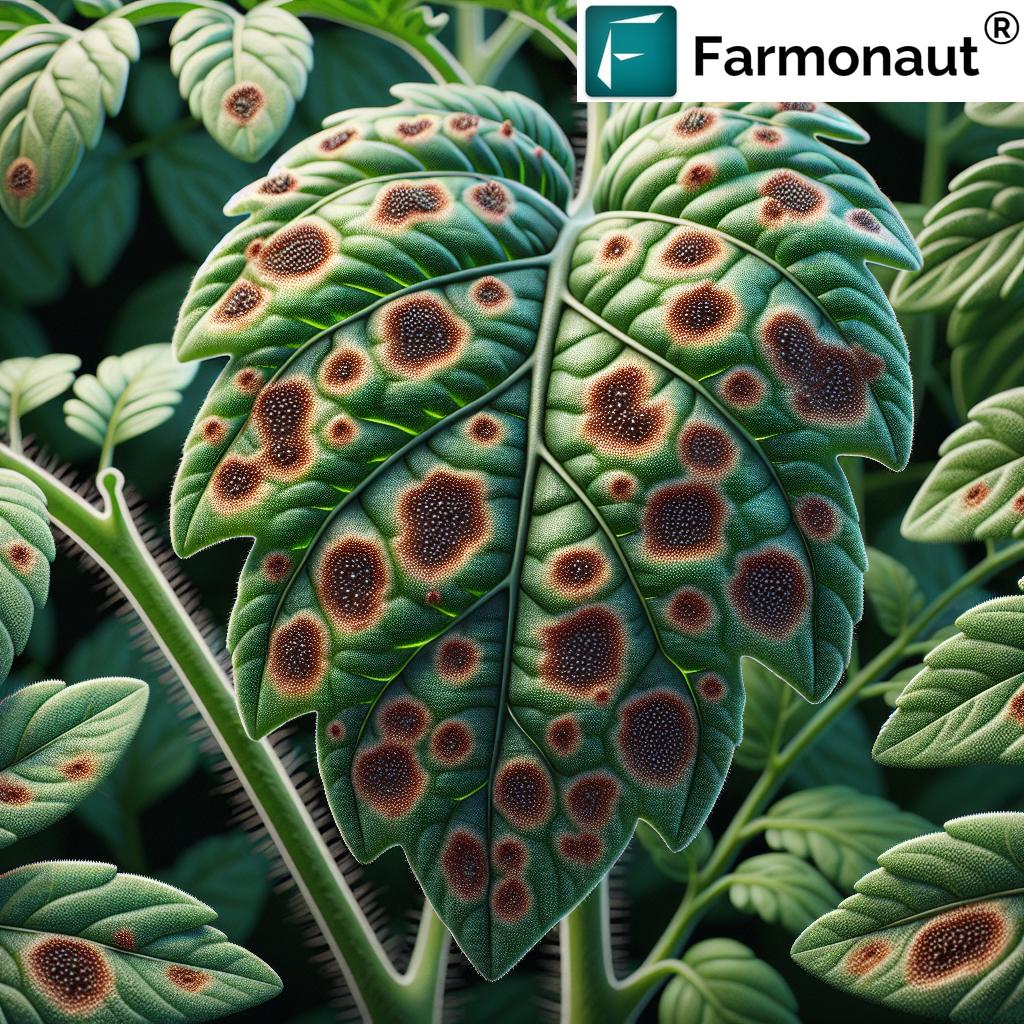Brown Patches on Leaves of Plants: Causes & Fixes 2025
Table of Contents
- Introduction
- What Are Brown Patches on Leaves of Plants?
- Quick Facts
- Major Causes of Brown Patches on Leaves
- Impact of Brown Patches on Agriculture, Forestry, and Plantations
- Diagnosis and Monitoring of Brown Patches
- Comparison Table: Brown Patch Causes, Symptoms, Yield Impact & Fixes
- Best Management Strategies for Brown Patches on Leaves in 2025
- How Farmonaut Supports Brown Patch Diagnosis & Management
- Frequently Asked Questions (FAQ)
- Future Perspectives: What to Expect Beyond 2025
- Conclusion
- Farmonaut Subscription Options
“Up to 50% of agricultural yield loss is linked to undiagnosed leaf brown patches each season worldwide.”
Introduction
Brown patches on leaves of plants are much more than a mere blemish; they are a symptom that signifies underlying issues affecting plant health, agricultural yield, and forest vitality. In 2025, as agriculture, forestry, and horticulture face evolving challenges from climate change, environmental pollution, and ever-adapting pathogens, understanding and managing the causes of these brown patches is more crucial than ever. For farmers, foresters, and plantation managers, rapid diagnosis of brown discolorations helps reduce yield loss, ensure sustainable crop and tree production, and protect economic interests.
This comprehensive guide will help you master the causes and management of brown patches on leaves, rooted in the most current research and 2025 best practices for integrated plant health management. Whether you’re monitoring crops in extensive agricultural fields, ensuring forest resilience, or improving plantations’ productivity, you’ll discover actionable strategies for diagnosis, intervention, and prevention.
What Are Brown Patches on Leaves of Plants?
Brown patches on leaves of plants—also called necrotic lesions, scorching, or leaf browning—are common symptoms observed across various plant types: from commercial field crops like wheat, rice, and maize, to orchard trees, forestry species, and ornamental horticulture. These brown, black, yellow-brown, or tan patches are a direct sign of damage to leaf tissues, often signaling underlying issues such as:
- Pathogenic infections (fungal, bacterial, or viral diseases causing foliar necrosis)
- Essential nutrient deficiencies (potassium, magnesium, or calcium shortfalls)
- Abiotic stress (drought, heat, excessive sunlight, chemical or herbicide injury)
- Environmental pollution (air pollutants near industrial zones, mining, or urban areas)
These symptoms are not merely aesthetic; they point to factors that may significantly affect yield, quality, and plant survival. Early understanding and management are imperative for farmers, foresters, and plantation professionals to ensure sustainable production and protect economic interests in their respective sectors.
“Fungal infections account for over 70% of brown patch cases reported in commercial plantations annually.”
Major Causes of Brown Patches on Leaves of Plants
Brown patches arise from a multitude of factors, often linked to environmental stress, pathogenic infections, nutritional deficiencies, or chemical damage. Let’s dive deeper into each major cause and explore how they result in browning across crops, forestry, and plantations.
1. Fungal and Bacterial Diseases: The Prevalent Cause
Pathogenic infections are by far the most common and concerning causes of brown patch development on plant leaves. Here’s how they work:
- Fungal Diseases: Alternaria, Septoria, Anthracnose, and leaf spot diseases thrive particularly in warm, humid conditions seen in many farming regions. These fungal pathogens induce brown or necrotic lesions on leaf tissues, rapidly spreading under moisture and temperature stress.
- Wheat & Rice: For instance, Bipolaris oryzae in rice (learn more) causes brown or tan spots with chlorosis and necrosis, leading to reduced photosynthesis and significant yield loss.
- Bacterial Diseases: Bacterial leaf spot infections induce water-soaked brown lesions, often surrounded by a yellow halo. Such damage impairs the plant’s vital physiological functions and spreads quickly during wet, warm periods.
- Tomatoes & Other Veg: Organic Septoria Control: Protecting Tomatoes and Cannabis from Fungal Pests
2. Nutrient Deficiencies: The Hidden Threat
Leaf browning, scorched margins, or interveinal necrosis are often direct results of nutrient shortfalls in soil. Essential elements like potassium, magnesium, and calcium play vital roles in regulating plant water balance, enzyme activation, and metabolic integrity.
- Potassium Deficiency: Initially manifests as yellowing (chlorosis), followed by brown necrosis along leaf edges. Potassium is crucial for regulating water movement and enzyme activity; its deficiency disrupts photosynthesis and weakens stress resistance.
- Magnesium Deficiency: Symptoms include interveinal chlorosis (yellowing between leaf veins), progressing to brown patches, especially in older leaves.

- Calcium Deficiency: Causes young leaf tips and growing points to turn brown and die back, affecting plant structure and fruit/seed quality.
-
For details on nutrient diagnosis and correction, see:
Farmonaut’s Large-Scale Farm Management Tool—use it to monitor nutrient status, soil health, and gain AI-powered recommendations for amendments.
3. Abiotic Stress Factors: Environmental Triggers
Rapidly changing weather and environmental fluctuations have made abiotic stresses a growing culprit for brown spots and scorching on leaves in 2025:
- Drought Stress: Insufficient soil moisture leads to leaf dehydration, resulting in browning at tips and margins.
- Excess Sunlight & Heat: Causes sunscald or leaf burning, especially in sensitive crop and horticulture species during peak summers.
- Chemical & Herbicide Injury: Accidental drift or overdose of pesticides, fungicides, or herbicides may cause spotting and necrosis, often seen as brown patches along leaf veins or spray areas.
4. Environmental Pollution: Industrial & Urban Threats
Plant species growing near industrial zones or mining areas are particularly at risk. Common pollutants include sulfur dioxide, ozone, heavy metals, and particulate matter, all of which cause damage to leaf tissues:
- Ozone Damage: Produces pale to reddish-brown spots that coalesce, leading to premature leaf drop.
- Sulfur Dioxide & Acid Rain: Cause widespread, diffused browning and loss of leaf tissue functionality, seriously affecting forest and plantation vitality.
- Use Farmonaut’s Carbon Footprinting Solution to monitor field and plantation proximity to pollution hazards, track carbon impact, and aid in advocating sustainable farming/forestry.
5. Other Common Contributors
- Pest infestations: Insects such as mites, thrips, and sucking pests can also cause brown necrotic spots either from direct feeding or introducing secondary infections.
- Varietal Sensitivity: Some plant species or cultivars are more susceptible to brown patch formation under stress than others. Mixed stands and genetic diversity in forestry help mitigate such risks.
- Natural Aging: Leaf browning at older, lower leaves is often a normal part of the senescence process, but widespread or rapid browning always signals a problem.
Monitor your fields, forestry assets, and plantations directly from your web or mobile device—track, detect, and address brown patches on leaves of plants wherever you are. Farmonaut makes advanced, satellite-driven insights affordable and accessible for everyone.
Impact of Brown Patches on Agriculture, Forestry, and Plantations
Brown patches on leaves of plants do not merely affect aesthetics—they indicate a reduction in plant health and that can have significant impacts:
- Reduced Photosynthesis: Damaged or necrotic tissues can no longer photosynthesize, directly leading to diminished biomass accumulation and lower yields in crops.
- Inferior Crop Quality: Fruits, grains, and foliage from affected plants tend to be lower in nutritional value, taste, and storage quality.
- Stress on Trees: Persistent brown patch symptoms in forests and plantations reduce tree growth rates, invite secondary infections, and compromise long-term vitality and regeneration.
- Economic Impact: Commercial plantations (tea, coffee, rubber, etc.) can see major decreases in leaf area and photosynthetic output due to leaf browning, directly affecting farmers’ incomes and supply chain resilience.
- Biodiversity: In forestry, recurring leaf disease outbreaks affect dominant tree species, influencing overall ecosystem health and biodiversity.
**For institutions aiming to enhance yield, product quality, and sustainability, actionable crop, plantation, and forest advisory is essential for intervention.**
Diagnosis and Monitoring of Brown Patches on Leaves
Early and precise diagnosis is the cornerstone of effective management for brown patches on leaves of plants. Here’s how best-practice monitoring works in 2025:
- Field Inspection: Regularly examine plants for symptoms—pattern of patches, lesion color, size, progression, and location (leaf margin, tip, or interveinal area).
- Laboratory Testing: Suspected pathogen-infected tissue can be cultured or tested via molecular diagnostics (PCR) to identify causal fungi or bacteria. Nutritional analyses supplement diagnosis.
- Soil & Tissue Analysis: Soil tests and plant tissue analysis help detect micronutrient and macronutrient deficiency, as well as potential toxicities or imbalances.
-
Remote Sensing and AI Monitoring:
- Satellite-based imagery (e.g., NDVI Normalized Difference Vegetation Index) detects early signs of leaf browning and stress across extensive fields and forest stands.
- Drones equipped with multispectral cameras and AI algorithms enable rapid detection and mapping of affected areas—game-changers in large-scale agriculture and forestry.
For an actionable overview:
Farmonaut Fleet Management helps coordinate site visits to hotspots, monitor vehicle/equipment usage, and boost diagnosis workflow efficiency.
Need to automate and scale up field diagnosis? Try Farmonaut’s Satellite API to integrate real-time, AI-powered detection of brown patches across leaves at farm, regional, or national level.
For developers: Find integration information in the API Developer Docs.
Comparison Table: Brown Patch Causes, Symptoms, Yield Impact & Fixes
| Cause | Visual Symptoms | Estimated Yield Loss (%) | Affected Plant Types | Recommended Fixes |
|---|---|---|---|---|
| Fungal Infections (Alternaria, Septoria, Anthracnose, Bipolaris oryzae) | Brown/black spots, concentric rings, necrosis, leaf drop | 20–50% | Cereals (wheat, rice), vegetables (tomato, chili), fruit, forestry | Fungicide (timely, targeted), resistant varieties, crop rotation, field sanitation |
| Bacterial Leaf Diseases | Water-soaked brown lesions, angular spots with yellow halo | 10–35% | Vegetables, fruit, field crops, some trees | Bactericide, seed treatment, avoid overhead irrigation, destroy crop residue |
| Potassium Deficiency | Leaf margin scorch (yellow, then brown), tip necrosis, stunted growth | 10–25% | Cereals (wheat, rice, corn), vegetables, fruit trees | Soil or foliar potassium fertilization, regular soil testing |
| Magnesium Deficiency | Interveinal chlorosis, brown spots on old leaves | 5–20% | Legumes, leafy vegetables, orchard trees, forestry | Epsom salt or magnesium fertilizer, pH adjustment |
| Calcium Deficiency | Tip burn, brown patches on young leaves, blossom end rot | 8–25% | Fruits (tomato, pepper), leafy vegetables, tree seedlings | Lime application, calcium foliar spray, consistent watering |
| Drought & Abiotic Stress | Brown/black scorching, crispy leaf edges, widespread browning | 15–40% | All crop types, trees, shrubs | Optimized irrigation, mulching, shelterbelts/windbreaks |
| Air Pollution (Ozone, SO2, industrial/urban) | Pale/rusty spots, widespread browning, premature leaf drop | 10–30% | Forestry, plantations (tea, coffee), urban & peri-urban crops | Buffer planting, advocate for pollution controls, monitor field location |
| Pests (mites, thrips, borers, etc.) | Necrotic feeding spots, stippling, speckled browning | 5–20% | Vegetables, fruit crops, young trees | IPM: biological/pesticide control, monitoring, remove weeds/hosts |
Best Management Strategies for Brown Patches on Leaves in 2025
Managing brown patches on leaves of plants requires an integrated, cause-based approach. Below are the most effective, research-backed management practices:
I. Disease Control
-
Fungal and Bacterial Diseases:
- Apply targeted fungicides or bactericides only after confirmed diagnosis (prevent resistance).
- Choose disease-resistant plant varieties and rotate different crops to break pathogen cycles.
- Practice strict field sanitation: remove infected debris, disinfect tools, manage irrigation to avoid leaf wetness.
-

II. Nutrient Management
- Correct Based on Soil & Tissue Tests:
III. Cultural and Environmental Management
- Optimize irrigation to avoid drought stress or waterlogging.
- Use mulching, windbreaks, and shade netting to protect sensitive crops or forestry seedlings from excessive sun, heat, and wind.
- Implement proper crop rotation, and maintain plant diversity within stands to disrupt disease and pest cycles.
- In polluted areas, establish buffer planting (rows of trees or shrubs) between plantations/fields and industrial zones or roads.
IV. Pollution Mitigation
- Advocate for stricter emission controls near industrial zones to protect crops and forestry assets.
- Use Farmonaut’s Carbon Footprinting Tool for environmental impact monitoring and compliance reporting.
V. Sustainable Practices for Forestry and Plantations
- Promote species diversity—mixed species stands are more resilient to diseases and stresses.
- Regular aerial or satellite monitoring to detect persistent browning and enable rapid intervention.
- Leverage Farmonaut’s Traceability Solution for transparent record-keeping from field to end product.
How Farmonaut Supports Brown Patch Diagnosis & Management
At Farmonaut, we integrate satellite technology, artificial intelligence (AI), and real-time advisory systems to empower farmers, forestry professionals, and plantation managers to detect and manage brown patches on leaves of plants early and efficiently. Here’s how our platform stands out in 2025:
- Satellite Monitoring: We use high-resolution multispectral images to monitor vegetation health (NDVI), alerting users to browning, patchiness, and stress signals even before visible on the ground.
- AI-Based Advisory: Our Jeevn AI system analyzes satellite and weather data to share actionable, crop-specific advice—including warning for brown patch-risk conditions and site-specific management guidance.
- Traceability: We help plantation/farm operators create digital logs verifying health status and management interventions for regulatory and supply chain documentation.
- Resource Optimization: Our fleet and resource management suite allows efficient site visits and rapid response to brown patch outbreaks in extensive agriculture or forestry.
-
API & Integration: Through
Farmonaut’s API, developers and enterprises can build custom solutions to detect brown patches and automate field interventions. -
Environmental Monitoring: Real-time tracking of pollution, carbon footprint, and risk factors through
carbon impact analysis.
Our mission is to make these advanced, satellite-driven insights affordable, accessible, and actionable—enabling agricultural and forestry industries to achieve maximum yield, quality, and long-term vibrancy—even as environmental and biotic stresses escalate in 2025 and beyond.
Frequently Asked Questions (FAQ) – Brown Patches on Leaves of Plants
-
What is the most common cause of brown patches on leaves in crops and plantations?
Fungal infections—especially by pathogens like Alternaria, Septoria, and Bipolaris oryzae—account for the majority of brown patch cases in commercial crops and plantations every season.
-
How can I distinguish between nutrient deficiency and disease-caused browning?
Nutrient deficiencies often show as diffuse interveinal chlorosis, browning at leaf margins/tips, and stunted growth. Disease patches are more likely circular, with a yellow halo or concentric rings, and may be water-soaked. Lab and soil testing provide confirmation.
-
How quickly do brown patches impact yield?
Severe or rapidly spreading brown patches can reduce effective leaf area for photosynthesis within days to weeks, significantly reducing yield if left unmanaged.
-
Can brown patches be reversed?
Already brown/necrotic tissue cannot recover, but rapid intervention (nutrient correction, disease control, irrigation) can prevent further progression and safeguard healthy leaves.
-
Is satellite or drone monitoring reliable for brown patch detection?
Yes—modern NDVI and multispectral imaging powered by artificial intelligence can detect patches and stress signals before severe symptoms appear on the ground, enabling early intervention across large/remote farms and forests.
-
What is the best way to prevent brown patches long-term?
Integrated best practices: balanced fertilization, disease-resistant varieties, periodic monitoring via remote sensing, diversity in plantings, and environmental pollution mitigation offer robust, long-term protection.
Future Perspectives: What to Expect Beyond 2025
As climate change continues to escalate and industrial zones expand, it is anticipated that incidents of brown patches on leaves of plants will rise in frequency and severity:
- Emergence of New Pathogens: Changing climate may favor new or mutated fungal, bacterial, or viral species.
- Greater Abiotic Stress: Environmental extremes (heat waves, drought, pollution spikes) will accelerate plant stress and brown patch formation in less-resilient cultivars.
- Technology in Management: Precision agriculture, genomics-driven breeding for resilience, and omnipresent AI-based monitoring (such as Farmonaut’s tools) will be essential for protecting plant health and economic returns.
- Sustainability: Environmental monitoring tools—like Farmonaut’s carbon impact feature—will become integral to sustainable, regulation-compliant farming and forestry worldwide.
- Traceability will be compulsory: Digital, blockchain-based supply chain documentation will allow buyers to verify that crops, forestry products, and produce are free from persistent brown patch damage.
Conclusion: Brown Patches as Plant Health Crucibles
Brown patches on leaves of plants are much more than a cosmetic symptom—they are early warnings of serious issues that impact plant yield, quality, and resilience. Understanding, accurately diagnosing, and effectively managing brown patches through integrated, technology-enabled approaches are crucial for farmers, foresters, and professionals to ensure sustainable, productive plant systems in 2025 and beyond.
With the right combination of field, lab, and satellite-based monitoring, plus timely intervention and AI-powered decision-making, the adverse effects of browning can be minimized, ensuring our agricultural, forestry, and plantation resources thrive in the years ahead.

Farmonaut Subscription Options
Ready to make real-time brown patch detection and health monitoring part of your agricultural, forestry, or plantation operation? Explore Farmonaut’s subscription options below:













